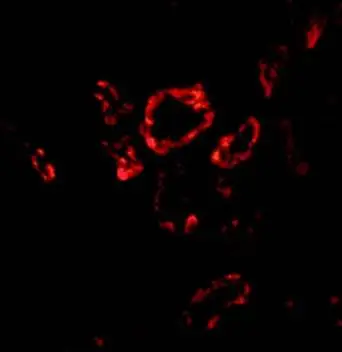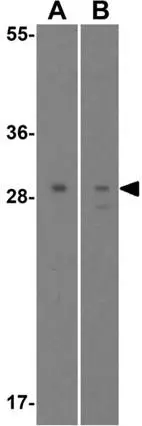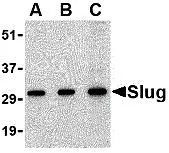
IHC-P analysis of human kidney tissue using GTX30813 SLUG antibody. Dilution : 20 microg/ml
SLUG antibody - Overexpression Validated

GTX30813
ApplicationsWestern Blot, ImmunoHistoChemistry, ImmunoHistoChemistry Paraffin
Product group Antibodies
ReactivityHuman, Mouse
TargetSNAI2
Overview
- SupplierGeneTex
- Product NameSLUG antibody - Overexpression Validated
- Delivery Days Customer9
- Antibody SpecificityThis antibody detects Slug and is not cross-reactive with Snail.
- ApplicationsWestern Blot, ImmunoHistoChemistry, ImmunoHistoChemistry Paraffin
- CertificationResearch Use Only
- ClonalityPolyclonal
- Concentration1 mg/ml
- ConjugateUnconjugated
- Gene ID6591
- Target nameSNAI2
- Target descriptionsnail family transcriptional repressor 2
- Target synonymsneural crest transcription factor SLUG; protein snail homolog 2; SLUG; slug (chicken homolog), zinc finger protein; SLUGH; SLUGH1; snail family zinc finger 2; snail homolog 2; SNAIL2; WS2D; zinc finger protein SNAI2
- HostRabbit
- IsotypeIgG
- Scientific DescriptionThis gene encodes a member of the Snail family of C2H2-type zinc finger transcription factors. The encoded protein acts as a transcriptional repressor that binds to E-box motifs and is also likely to repress E-cadherin transcription in breast carcinoma. This protein is involved in epithelial-mesenchymal transitions and has antiapoptotic activity. Mutations in this gene may be associated with sporatic cases of neural tube defects. [provided by RefSeq, Jul 2008]
- ReactivityHuman, Mouse
- Storage Instruction2°C to 8°C,-20°C or -80°C
- UNSPSC12352203
References
- Fibroblast growth factor 2 induces proliferation and fibrosis via SNAI1-mediated activation of CDK2 and ZEB1 in corneal endothelium. Lee JG et al., 2018 Mar 9, J Biol ChemRead more
- Reverse epithelial-mesenchymal transition contributes to the regain of drug sensitivity in tyrosine kinase inhibitor-resistant non-small cell lung cancer cells. Lee AF et al., 2017, PLoS OneRead more


